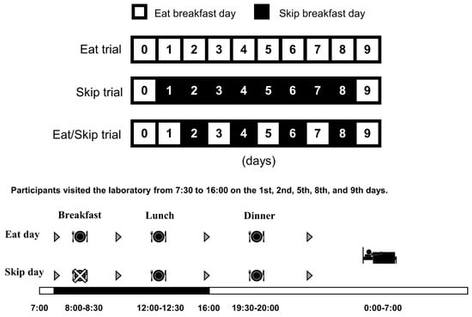- Article
Regular or Irregular Breakfast Skipping Suppresses the Vascular Endothelial Function of the Brachial Artery
- Hideaki Kashima,
- Yui Morinaka and
- Kano Endo
- + 8 authors
Background: Habitual breakfast skipping is associated with an increased risk of cardiovascular and cardiometabolic diseases. However, the effects of skipping breakfast regularly versus irregularly on vascular endothelial function (VEF), a key marker of cardiovascular health, remain unclear. This study aimed to investigate the effects of eight-Day regular or irregular breakfast skipping on brachial artery VEF in healthy habitual breakfast eaters using a three-condition, randomized controlled crossover trial. Methods: Ten young healthy adults (seven females, three males) completed three randomized nine-Day trials: (1) Eat (three meals per day), (2) Skip (breakfast skipped on days 1–8, consumed on Day 9), and (3) Eat/Skip (alternating breakfast consumption and skipping). Flow-mediated dilation (FMD) of the right brachial artery was assessed at 7:45–55 am on days 1, 2, 5, and 9, expressed as the percentage change in the brachial artery diameter normalized to the shear rate area under the curve (Δ%FMD/SRAUC). Blood samples were collected before and 30 min after breakfast or lunch for glucose, insulin, free fatty acids, and triglyceride analyses. Insulin resistance was estimated using the homeostasis model assessment of insulin resistance calculated from fasting glucose and fasting insulin values. Objective measurements of sleep, physical activity, and continuous glucose monitoring were obtained. Results: On Day 9, the Skip and Eat/Skip trials had significantly lower %FMD/SRAUC and significantly higher levels of fasting plasma insulin than the Eat trial. Exploratory analyses within the Skip and Eat/Skip trials suggested a weak negative association between changes in %FMD/SRAUC and fasting blood glucose and insulin from day 1 to day 9. Conclusions: These findings suggest that both regular and irregular breakfast skipping may impair early morning VEF, possibly through alterations in glucose metabolism, whereas regular breakfast consumption may help preserve VEF and support cardiovascular health. Clinical Trial Registry: Clinical Trial Registry: University Hospital Medical Information Network (UMIN000053117, registered 20 December 2023).
15 October 2025







